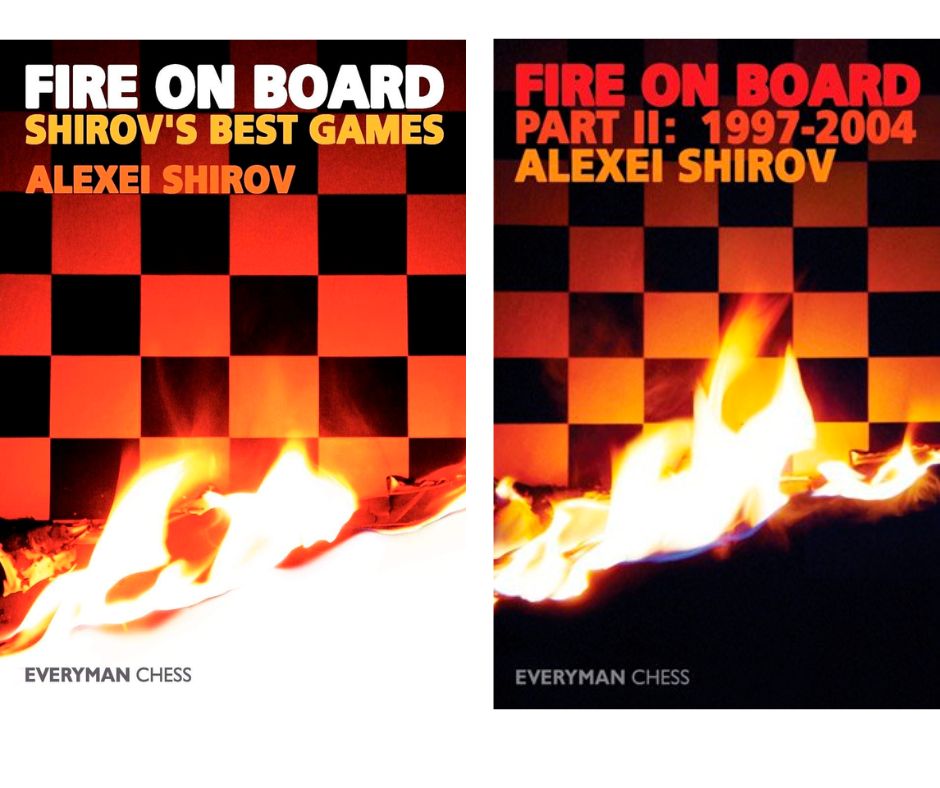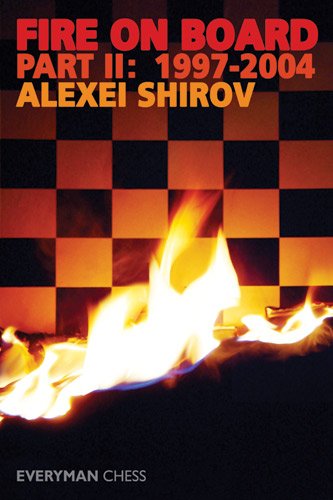I mainly play d4 in chess and rarely e4. That’s because I prefer positional chess.
However, I’m not afraid to mix things up (at any point) with some provocative, tactically interesting moves that leave my opponents scratching their heads.
That is to say, I’m always looking for ways to add more fire to my game, whether I’m playing over the board or online.
The point is to thrive on complicated positions that keep me on my toes and make my opponents play weak and bad moves consecutively.
So that necessitated the hunt for a book to achieve this desire of mine when I stumbled upon ‘Fire on Board’ by Alexei Shirov.
This beautiful book is divided into two parts and is packed with some of Shirov’s most memorable games.
Just so you know, Alexei Shirov is a Latvian-Spanish player who ranked number 2 in the world in 1994. He is one of the most creative and exciting chess players of our time.
His style is characterized by sharp tactics, brilliant sacrifices, and daring attacks. His games are full of fire and passion, and they often leave his opponents and spectators in awe.
Let’s take a look at both books.
Fire On Board: Shirov’s Best Games by Alexei Shirov
In his book, Grandmaster Alexei Shirov shares his best games and explains why he is considered one of the most aggressive and innovative players of the modern era. The book includes a selection of his favorite games, each of which is explained in detail, along with sections on tactics and endgames. Shirov also focuses on the super-sharp Botvinnik variation, which he has used to great effect against some of the world’s top players.
In the first volume of his book ‘Fire On Board: Shirov’s Best Games’, he presented 100 of his most memorable and instructive games, which he annotated with so much honesty and insight.
The book covers his chess career from his childhood in Latvia to his rise to the top of the chess world in the 1990s.
The book is divided into five chapters, each focusing on a different aspect of his chess development and achievements.
Let’s see this in detail.
Chapters Summary (of Part 1)
The first chapter, Growing Up (1979-1987), shows his early influences and his progress as a young talent.
He shared his first encounters with grandmasters, his successes in junior tournaments, and his experiments with different openings and systems.
The second chapter, Winning the World Cadet (1988), recounts his triumph in the World Under-16 Championship in Romania, where he scored 10.5/11 and won the gold medal.
He analyzes his games from that event and reveals his secrets of preparation and motivation.
The third chapter, Professional Chess Life (1989-1996), covers his most productive and successful period as a chess professional.
He describes his victories in various tournaments, his matches against top players, and his participation in the Candidates cycle for the World Championship.
He also explains his opening choices, his strategic concepts, and his tactical vision.
The fourth chapter, The Botvinnik Variation, is dedicated to his favorite and most famous opening, the Botvinnik System in the Semi-Slav Defense.
He shows how he mastered this complex and rich opening, and how he used it to create many masterpieces and novelties. He also gives his opinion on the current state and future prospects of this opening.
The fifth chapter, Selected Endgames, showcases his endgame skills and his ability to convert advantages or save difficult positions. He demonstrates his knowledge of theoretical endgames, his practical endgame technique, and his endgame intuition.
The book also contains an index of opponents, an index of openings, an index of variations in the Botvinnik System, and an index of endgames.
The book is illustrated with many diagrams and photos, and it is written in a lively and engaging style.
In summary, ‘Fire On Board: Shirov’s Best Games’ is a book that inspires and educates its readers irrespective of playing level.
The book shows you the beauty and the complexity of chess, and the genius and the passion of Alexei Shirov.
I also recommend it to anyone looking to add some spice to their chess game.
Fire On Board Part II from 1997-2004 by Alexei Shirov
Fire on Board Part II is a continuation of his previous best-selling book and includes a detailed explanation of his progress in the chess world since 1996. Shirov provides a delightful selection of his favorite games, each of which is explained in great detail to the reader.
Taking a dip into this book, we see that it’s the continuation of the first volume as it similarly focuses on Shirov’s creativity in games and teaches the possibilities of replicating the same in your games.
Alexei Shirov wrote and published this second volume of his best-selling book ‘Fire On Board’ in 2005.
This volume covers the period from 1997 to 2004 when he reached the peak of his rating and played some of his most spectacular and memorable games.
Chapters Summary (of Part 2)
The book is divided into three chapters, each with a different theme and focus.
The first chapter, The Struggle without Limits (1997-2004), shows his battles against the world’s elite, such as Kasparov, Kramnik, Anand, Topalov, and Leko.
He also recounts his experiences in the FIDE World Championship tournaments, where he came close to winning the title twice, but lost in the final matches against Karpov and Khalifman.
He analyzes his games with honesty and depth and reveals his thoughts and emotions during the critical moments.
The second chapter, Notes on Creativity, is a fascinating essay where he reflects on the nature and sources of creativity in chess.
He discusses the role of intuition, inspiration, and imagination, and how they relate to calculation, logic, and knowledge.
He also gives his opinion on the influence of computers and engines on chess, and how they affect the creative process and the quality of the games.
The third chapter, Selected Games, is a collection of 50 games that he considers to be his best or most interesting from that period.
He annotates them with his trademark style, full of insights, explanations, and variations. He also adds some comments from his opponents or other sources, to give a different perspective or to correct some mistakes.
The games were arranged in chronological order, and they covered a wide range of openings, middlegames, and endgames.
The book also contains an index of opponents, an index of openings, and a bibliography.
The book has a vivid and easy-to-read writing style and is filled with several illustrations and pictures.
My thoughts on this? ‘Fire On Board Part II from 1997-2004’ is a book that every chess fan should read and enjoy.
Reading these books (1 & 2) made me embrace harder positions and complications, which helped me improve my middlegame play and overall sensitivity of the entire board.


